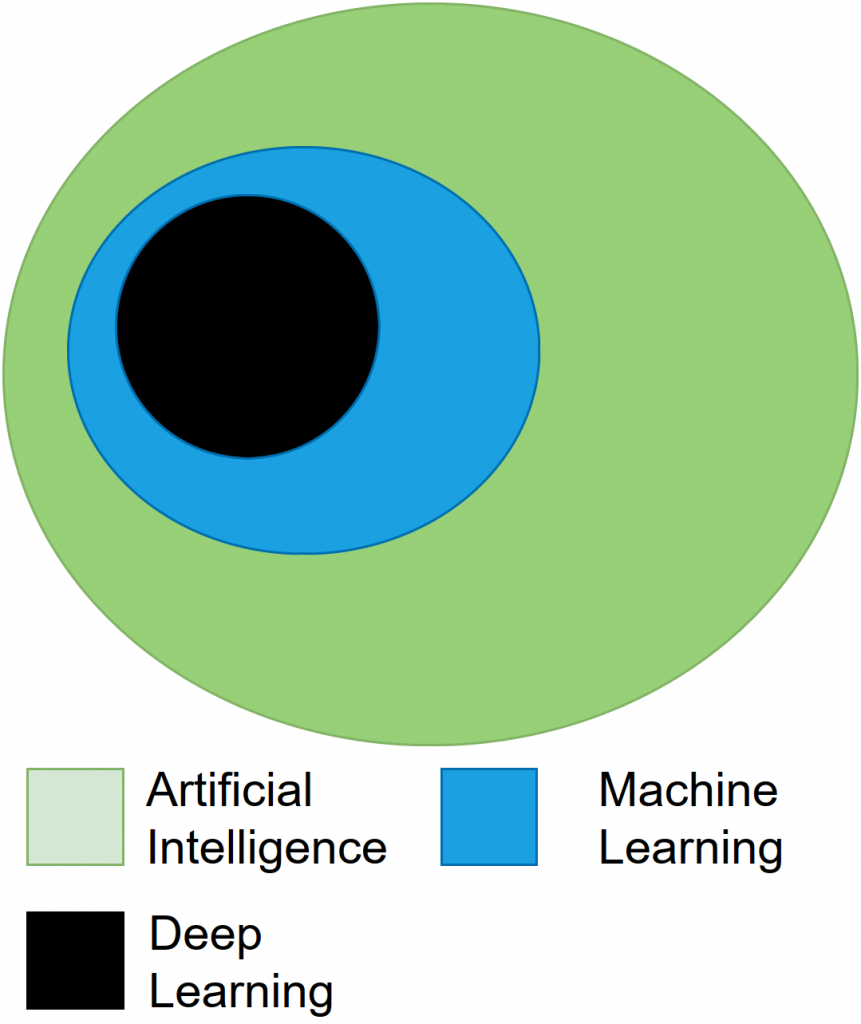Machine vision and computer vision terminology might be confusing. Here is a definition, that we will use in this website.
The first high-level term in this field was computer vision. Since the core of the 1970s intelligent robot was a vision, the research area was named after it (Ejiri 2007). In terms of research content, however, the case and name refer more to the current interpreter of machine vision.
According to Smith et al. (2021), the current de facto interpretation of machine vision is “computer vision techniques to help solve practical industrial problems that involve a significant visual component”. The state-of-the-art interpretation combines machine vision and deep learning methods and considers machine vision as one of the core technologies of artificial intelligence (Smith et al. 2021).

intelligence, machine learning and deep learning. Machine learning is a subset of artificial intelligence, and deep learning is a subset of particular machine learning.
Figures 1 and 2: Deep and overlapping terminological relationships between artificial intelligence, machine learning, deep learning, machine vision and computer vision. (Original image source: Smith et al. (2021)).
Above, Figures 1 and 2 illustrate the relationships and overlapping terminology of the research fields, which form the basis of machine vision. Figure 1 shows how deep learning is a part of machine learning, and machine learning can be seen as a subset of artificial intelligence. Term machine vision includes computer vision based on machine learning (Figure 2).
The role of machine vision as a core technology of artificial intelligence has undergone revolutionary developments in recent years (Smith et al. 2021), which may partly explain why the term machine vision can be misused or confused with computer vision. In the era of big data, the Internet provides plenty of databases and collections of different types of imaging data. Thus, machine learning models for image analysis can be developed and examined without the data-capturing phases.
As can be seen in research examples (Geirhos et al. 2021; Jia et al. 2013), the term machine vision can be found even in scientific contexts (or everyday language) used as a term for image data processing, which is the essence of computer vision. The definition of machine vision involves image capturing and image processing phases, as seen below in the machine vision fundamentals (Figure 3).
Machine vision fundamentals
We will define the terms according to (Uma and Sukanya 2021) and (Smith et al. 2021). Computer vision covers image processing phases gaining a deep understanding of the material provided by machine vision’s image acquisition phase. In contrast, machine vision is a higher-level term that describes all the fundamental phases of image capturing and computer vision.
The fundamentals are visualised in Figure 3, which was first introduced in the author’s dissertation, being inspired by the literature (e.g., Uma and Sukanya (2021); Smith et al. (2021) and Usama et al. (1996)). Figure 3 summarises the terminology and visualises the foundation of the machine vision fundamentals, which will be covered in the posts.
Found something useful? Wish to cite? This post is based on my dissertation. For citations and more information, click here to see the scientific version of it.
References
Ejiri, M. 2007. Machine vision in early days: Japan’s pioneering contributions. In Y. Yagi, S. B. Kang, I. S. Kweon & H. Zha (Eds.) Computer Vision –ACCV 2007. Berlin, Heidelberg: Springer Berlin Heidelberg, 35–53. doi:10.1007/978-3-540-76386-4_3.
Geirhos, R., Narayanappa, K., Mitzkus, B., Thieringer, T., Bethge, M., Wichmann, F. A. & Brendel, W. 2021. Partial success in closing the gap between human and machine vision. Advances in Neural Information Processing Systems 34, 23885–23899. doi:https://doi.org/10.48550/arXiv.2106.07411.
Jia, Y., Abbott, J. T., Austerweil, J. L., Griffiths, T. & Darrell, T. 2013. Visual concept learning: Combining machine vision and bayesian generalization on concept hierarchies. Advances in Neural Information Processing Systems 26.
Smith, M. L., Smith, L. N. & Hansen, M. F. 2021. The quiet revolution in machine vision – a state-of-the-art survey paper, including historical review, perspectives, and future directions. Computers in Industry 130, 103472. doi:https://doi.org/10.1016/j.compind.2021.103472.
Uma, J. & Sukanya, B. 2021. A survey on recent trends in machine vision. SSRN, Proceedings of the Yukthi 2021- The International Conference on Emerging Trends in Engineering – GEC Kozhikode, Kerala, India -. doi:https://doi.org/ 10.2139/ssrn.3972999. ⟨URL:https://ssrn.com/abstract=397299⟩.
Usama, M., Piatetsky-Shapiro, G., Smyth, P. & R, U. 1996. Advances in knowledge discovery and data mining. AAAI Press.


